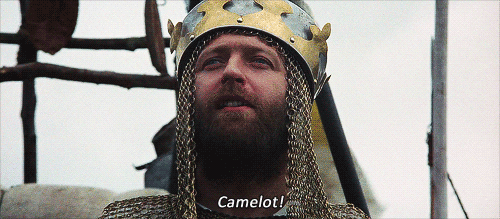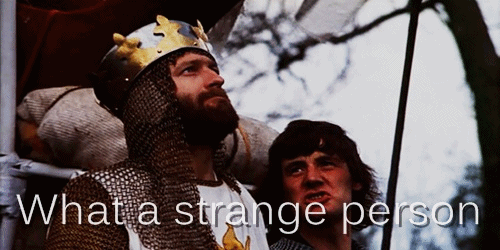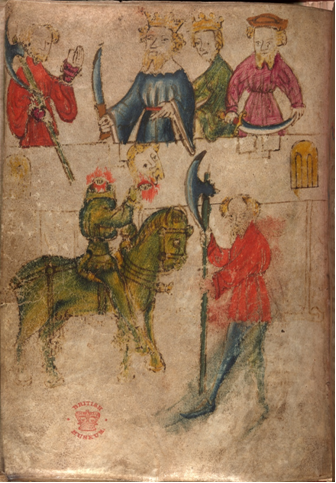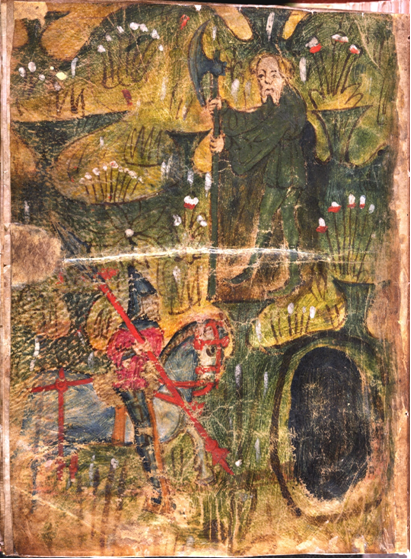[This post, part of an effort to merge our undergraduate and graduate blogs, was written in response to an essay prompt for Kathryn Kerby-Fulton's undergraduate course on "Chaucer's Biggest Rivals: The Alliterative Poets." It comes from the former "Medieval Undergraduate Research" website.]

Sir Gawain and the Green Knight (1.250-278):
And rekenly hym reuerenced, for rad was he neuer,
And sayde, ‘Wyȝe, welcum iwys to þis place, [folio 94v]
Þe hede of þis ostel Arthour I hat;
Liȝt luflych adoun and lenge, I þe praye,
And quat-so þy wylle is we schal wyt after.’
‘Nay, as help me,’ quoþ þe haþel, ‘he þat on hyȝe syttes,
To wone any quyle in þis won, hit watz not myn ernde;
Bot for þe los of þe, lede, is lyft vp so hyȝe,
And þy burȝ and þy burnes best ar holden,
Stifest vnder stel-gere on stedes to ryde,
Þe wyȝtest and þe worþyest of þe worldes kynde,
Preue for to play wyth in oþer pure laykez,
And here is kydde cortaysye, as I haf herd carp,
And þat hatz wayned me hider, iwyis, at þis tyme.
Ȝe may be seker bi þis braunch þat I bere here
Þat I passe as in pes, and no plyȝt seche;
For had I founded in fere in feȝtyng wyse,
I haue a hauberghe at home and a helme boþe,
A schelde and a scharp spere, schinande bryȝt,
Ande oþer weppenes to welde, I wene wel, als;
Bot for I wolde no were, my wedez ar softer.
Bot if þou be so bold as alle burnez tellen,
Þou wyl grant me godly þe gomen þat I ask
bi ryȝt.’
Arthour con onsware,
And sayd, ‘Sir cortays knyȝt,
If þou craue batayl bare,
Here faylez þou not to fyȝt.’
My Translation:
Then Arthur, before the high dais, that adventure/strange happening beheld
And courteously greeted him, for afraid was he never,
And said: “Knight, welcome indeed to this place.
The head of this hostel, Arthur I am called.
Dismount graciously down and stay, I pray thee,
And what your will is, we shall learn after.”
“Nay, so help me,” said the knight, “He that on high sits,
To dwell any while in this abode was not my errand;
But for the renown of thee, Prince, is lifted up so high
And your castle and your knights are held [to be] best,
Stiffest/Strongest under steel-gear on steeds to ride,
The strongest and the worthiest of the world’s offspring,
Valiant to play with in other noble games,
And here is shown that courtesy, as I have heard mention of–
And that has brought me here, certainly, at this time
You may be safe by this branch that I bear here
That I pass as in peace and seek no plight;
For had I set out in company in a fighting fashion,
I have a hauberk [plate of armor] at home and a helmet both,
A shield and a sharp spear, shining bright,
And other weapons to wield, I know [they are] good, also;
But for I don’t want there to be, my clothing is gentler.
But if thou would be so bold as all men say [you are],
Thou will grant me goodly the game that I ask
By right.”
Arthur did answer
And said: “Sir courteous knight,
If thou crave bare battle,
Here you will not fail to fight.”
My Analysis:
The Gawain-poet takes on the Arthurian and the alliterative traditions in Sir Gawain and the Green Knight, as is aptly demonstrated in this passage from lines 250-278. In this scene, Arthur addresses the mysterious Green Knight who appears at the entrance to his hall. The poet begins the passage, noting “þat auenture” standing before Arthur’s court (1.250). This adventure, or marvel, alludes to the same “meruayle þat he he myȝt trawe, / Of alderes, of armes, of oþer auenturus” that Arthur seeks earlier before being seated for dinner (1.94-95). Arthur’s request for a tale of adventure is a traditional aspect of Arthurian literature. In this poem, however, it is revealed as a potentially childish request, as the poet takes on the tradition, exaggerating the adventure to one more dangerous and real than Arthur would perhaps have originally desired.
The poet is also successful in portraying the noble courtesy that was traditional behavior for knights. Line 251 emphasizes this type of courtly behavior, utilizing alliteration of three words, as was custom in the alliterative tradition of the time: “And rekenly hym reuerenced, for rad was he neuer.” Arthur applies this same type of courtesy to the green guest, welcoming him, “Wyȝe, welcum iwys to þis place. /…/ Liȝt luflych adoun and lenge, I þe praye” (1.252-254). The alliterated words (wyȝe, welcum, iwys, and liȝt, luflych, lenge) emphasize the chivalric greeting given to the Green Knight, likely because of the high quality materials he wears, described in an earlier passage.
It is important to note that by addressing the Green Knight in a chivalric manner, Arthur employs the formal and respectful “þe” (1.253), in comparison to the Green Knight’s disrespectful use of “þou” (1.272). This foreshadows the sinister intentions of the Green Knight, corresponding with the likewise dual-natured description of his appearance in previous passages: the knight is ominously giant and green, but outfitted like a noble knight and is therefore difficult to define as specifically “good” or “bad.” The Gawain-poet hints at the Green Knight’s deceptive character a second time in this same passage, when the knight says Arthur’s court is “Preue for to play wyth in oþer pure laykez,” alluding to the subsequent beheading game, as “oþer pure laykez” indicates games rather than jousting (1.262). The Green Knight’s cunning deception can be seen as the Green Knight’s “oþer weppenes to welde” (1.270). The poet draws attention to these lines in the notable occurrence of translinear alliteration. Lines 270 and 271 both alliterate on long vowel sounds that begin with “w”: “Ande oþer weppenes to welde, I wene wel, als; / Bot for I wolde no were, my wedez ar softer.” The poet’s emphasis on these lines indicate to the reader that the Green Knight’s focus on appearance of clothing as indicative of his nature is important—should the knights trust that the Green Knight’s clothing and appearance can guarantee his real intent? Yet again, the poet serves at a critic of the court, suggesting a childish gullibility within it.
Marie Borroff handles this passage well in her translation, maintaining most key aspects of the passage’s stylistic nuances. There are, however, significant alterations that sacrifice some of the poem’s integrity. Perhaps most significantly, her translation foregoes much of the allusions to the malevolent character of the Green Knight. Most obviously, this is lost where Borroff replaces both the words “þe” and “þou” with the umbrella-word, “you.” Any nuance in tone is erased with this replacement, resulting in a much more deferential Green Knight. The Green Knight’s previously discussed use of “ȝou” to address Arthur reveals the costume nature of his attire, as his language here disagrees with the noble appearance of his attire. A true knight would be required to behave and speak in the same chivalric fashion Arthur displays.
Her choice of “you” is problematic in another instance in the passage, when Arthur returns the favor to the Green Knight, addressing him, “If þou craue batayl bare, / Here faylez þou not to fyȝt” (277-278). Arthur addresses the Green Knight with a reciprocating “þou” twice within the wheel structure; evidently the poet wants to draw attention to this change in language coming from Arthur. Borroff misses this emphasis on his change in tone when she uses the less nuanced “you,” writing “If contest here you crave, / You shall not fail to fight.” It is, however, important to note that there aren’t many modern equivalents for Borroff to choose from in terms of polite and impolite forms of “you,” so her loss can easily be attributed not to any oversight on her part, but to a true lack of modern equivalent English to select from.
Borroff further fails in her portrayal of the Green Knight when she substitutes words and phrases so as to maintain the alliterative pattern of her translation. She translates “Preue for to play wyth in oþer pure laykez” (1.262) to “And peerless to prove in passages of arms.” While her translation succeeds in maintaining the rhythmic and alliterative integrity of the original, the meaning is twisted in such a way that it loses its original allusion to the beheading game (oþer pure laykez). Yet again, the Green Knight is portrayed without key allusions to his deception, losing the poetic nuance of foreshadowing.
This occurs again in line 266: “Þat I passe as in pes and no plyȝt seche.” Borroff’s translation, “That I pass here in peace, and would part friends,” again prioritizes the alliterative style over meaning, and the Green Knight becomes the friendly giant, wishing to befriend the court before him. He assures them that his bearing of a traditional Christmas branch indicates his desire for peace, as was custom at the time. This is certainly not the case, as he, in reality, wishes to deceive and test them. The original verse is much more ambiguous, for it is unclear as to whose plight he does not seek—probably, he seeks no plight for himself and merely allows the possibility that there be none for the other knights, should they, of course, pass his test. This is yet another key example of the Green Knight waving the falsity of his appearance in the naïve court’s faces; he almost mocks the act of bearing a branch to represent peace and toying with the youthful naïveté of Arthur’s court. These nuances are all sacrificed in Borroff’s representation of the Green Knight, yielding the loss of poetic foreshadowing and poetic critique within the poem.
The poet’s role as a potential critic of the court is made less pronounced in line 250 of Borroff’s translation, where she omits the word “auenture,” choosing “entrance” instead. This decision erases the implication that Arthur’s previously desired tale of marvel and adventure has been presented through the arrival of the Green Knight. The irony of the entire matter is lost and the poet loses one of his key criticisms. It is perhaps fitting, given her failure to portray the Green Knight’s allusions to his dangerous intentions, that she fail to present him as Arthur’s “auenture” to begin with. This alteration, along with many others, is very slight but also very pronounced when closer readings of the original text lend to truly wonderful poetic devices and subtleties that the translation simply lacks. The greatest attributes of the Gawain-poet are his nuanced and intricate style, playing performer, insider, and critic for and of the court, all at once. Borrof’s choices may have reflected ones necessary to best reproduce the poem in its stylistic character with a meaning as close to the original as possible, but her selections reveal the impossibility of doing so while maintaining the original’s subtle and well-crafted overtones.


Margaret Quinn
University of Notre Dame

